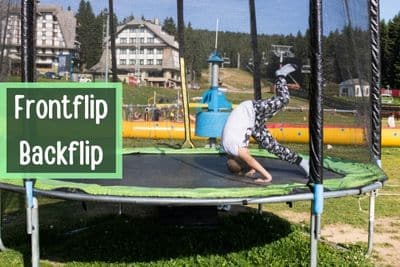Maybe you have seen trampoline shows at the Olympic events or other competitions. The gymnasts show off superb jumping and tumbling performances there, right? These journeys of amazing trampoline stunts mostly start with front flips and back flips.
So, how to do a front and backflip on a trampoline? This is not anything except practicing and controlling your body to fly and land on the trampoline rightly. Once you learn it you will never get tired of showing them off. But learning those tricks is going to need a bit of effort.
Well, you are not alone everyone comes to this stage where getting a step ahead to do stunts on the trampoline becomes absolutely necessary for all jumpers. This blog will explain the steps of learning frontflip and backflip step by step. So, if you are a beginner, let’s do it.
Note: Don’t try to learn frontflip or backflip alone without the supervision of a trampoline instructor. This may cause injury.
How to Do a Frontflip on a Trampoline?
Frontflip is a kind of summersault, but up in the air. Before doing a frontflip, it’s important to do some warm-ups and neck stretches. These will ease your front flip attempts.

The steps on how to frontflip on a trampoline include-
- Start with regular somersaults
- Jump in the air
- Try to jump without using your hands
- Attempt to flip forward
- Improve your landing
Let’s discuss them in detail.
Step 1: Start with Regular Somersaults
Keep your back a little rounded and put your thin on the chest. Now roll yourself forward placing your hands and head on the trampoline.
Try to land on your legs. If you aren’t confident to land on your legs, land on your butt for the first few rolls.
See Also: Amazing benefits of trampoline exercise
Step 2: Jump in the Air
Now try to roll in the air a little differently than the previous somersaults. Hit the trampoline mat with your legs, and jump forward on the trampoline making your body round.
You may put your hands on the trampoline mat for the several first trials. Land on the butt at the beginning and then try to land on your legs.
Keep doing this for at least 10 to 20 minutes to make it perfect. Once you master it, increase the height. With every jump, try to increase the height slowly each time.
You can use a foam mattress to comfort and confidence. But it’s better to do it without a mattress.
Step 3: Try to Jump without Using Your Hands
At this time, bounce and roll front in the air again, but this time, try to complete the jump without touching the mat by hand. Whenever you jump, just bring your hand near on chest and keep doing the rolls.
See Also: Is trampoline good for gaining height?
Step 4: Attempt to Flip
Then go for tuck or flip. To do tuck, hit the trampoline mat with your feet, spin your body in the air grabbing your knees. To do this, you have to throw your arms overhead.
The first few flips are going to be tricky, but you will make it to your feet for sure. Just focus on your timing and commitment to do the perfect front flip.
Step 5: Improve Your Landing
During the first few flips, your landing posture mightn’t be perfect. But, try to land on the butt without hurting yourself and keep doing the flips until you can land on your legs.
For visual learners, the following video might help you learn how to land a front flip on a trampoline.
See Also: Tips to do yoga on trampoline
How to Do a Backflip on a Trampoline?
A backflip is a backward summersault, but up in the air. Before your backflip, do some basic warm-ups first to ease the process.
To do a backflip on the trampoline, follow these steps-
- Start with back jumps
- Attempt for back tucks
- Go for pullovers
- Attempt for backflips
- Improve the landing

Let’s explain these steps.
Step 1: Start with Back Jump
Begin with jumping on your back. Try to jump higher one after another. Be sure your back is on the trampoline, and your legs are up while you’re landing.
Step 2: Attempt for Back Tuck
Now do some tuck in the backside. So, grab your legs in the air. Practice this for 10 to 20 minutes. Use your arm to balance rotation.
Step 3: Go for Pullovers
At this time, practice some pullovers. This will develop your rotation skill which is important for doing backflips. You can do multiple pullovers in a row too.
See Also: How many calories do trampoline burns?
Step 4: Attempt for Backflip
When you are confident about your back jump and back pullover, try backflip now. So hit the trampoline mat using your feet, and spin your body in the air backward.
So, your backflip on the trampoline is almost done. Now you have to land properly. In the first several trials, you can use an additional foam mattress which will reduce your mental stress.
Step 5: Improve the Landing
For the first few backflips, you might land on your knees. But try to land on your legs. Don’t worry; you can do it perfectly after practicing for a while.
Congratulations on learning the trampoline backflip.
The following video shows the step-by-step guidelines to backflip easily on the trampoline.
Different Types of Front Tucks and Back Tucks
Well, don’t be surprised. There are much more types of frontflips or backflips than you have ever thought. It’s not just bound to double flips or triple ones. But I will be mentioning the most popular ones here.
Front Handspring
A kind of front flip that rotates frontward by leaning your hands against the surface.
Barami
Front flip with a half twist before landing.
Kaboom
It can be of two types. A frontside full rotation from a front drop position and another one is a backside rotation from the backdrop position.
See Also: How to do double bouncing on a trampoline?
Lazy Backflip
Three-quarter back somersault with landing on your stomach.
Back Layout
A backflip without tucking your legs.
Cody
A kind of backflip that is done from the front drop position.
Gainer
Backflip performed with moving forward.
Well, that’s a few flips that I love the most among the heavy bunch. But I’m sure you can find your favorite ones too when you start exploring.
See Also: Several basic mini-trampoline exercises
Is It Safe to Do a Backflip on a Trampoline?
Yes, there are some safety hazards to doing backflips on a trampoline. So, it’s important to consider these before you attempt backflips. Some of them are-
- Backflip on a trampoline poses to risk of injury. A wrong landing could cause severe injuries to the neck, chest, legs, etc.
- Doing backflips on a trampoline puts a lot of stress is produced on the spine and neck. So, if you have previous back pain, don’t do it.
- If you don’t have basic jumping skills or you aren’t confident, go for a backflip.
See Also: Side effects of trampolining
Safety Tips to Flip on Trampoline
- Don’t rush to flip. Just keep practicing, and when you feel confident, go for frontflip or backflip.
- Children (especially those under 6 years) should refrain from trampoline backflips.
- Learn flips under the supervision of a trampoline instructor. Don’t practice this alone; otherwise, severe injuries may occur.
- Jump as high as possible while doing frontflip or backflip. The higher you jump, the more confidently you can do flips in the air.
- Be sure the trampoline is big enough. It’s recommended to use over 12 ft trampoline for flips.
- The trampoline should be leveled well; otherwise, unpleasant injuries may occur.
- Make sure the trampoline is surrounded by an enclosure net and the springs are covered by a thick safety pad.
Wrap Up
Front and backflips on a trampoline are essential skills for gymnasts. Perfection on front tuck or back ones depends on how well you are committed to the work and get better with practicing every time.
While backflips or frontflips on the trampoline be sure you take the necessary safety precautions to minimize the risk of injury. After learning these trampoline tricks impress your fiancé or favorite person.

Rebecca is a fitness nerd and mother. She was inspired to get into the world of trampolining and rebounding by her husband Robert, who is a well-respected trainer and expert in the field. Now she instructs children, mothers, and teens the basic trampolining and rebounding tricks.
Rebecca is also a passionate blogger, sharing her knowledge and experiences with others in the hope of encouraging them to give trampolining and rebounding a try.
